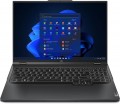Model
The specific model of the processor installed in the laptop, or rather, the processor index within its series (see above). Knowing the full name of the processor (series and model), you can find detailed information on it (up to practical reviews) and clarify its capabilities.
Code name
The code name for CPU installed in the laptop.
This parameter characterizes, first of all, the generation to which the processor belongs, and the microarchitecture used in it. At the same time, chips with different code names can belong to the same microarchitecture/generation; in such cases, they differ in other parameters - general positioning, belonging to certain series (see above), the presence / absence of certain specific functions, etc.
Nowadays, the following code names are relevant in Intel processors:
Coffee Lake,
Comet Lake,
Ice Lake,
Tiger Lake,
Jasper Lake,
Alder Lake,
Raptor Lake (13th Gen),
Alder Lake-N,
Raptor Lake (14th Gen),
Meteor Lake (Series 1),
Raptor Lake (Series 1),
Lunar Lake (Series 2),
Arrow Lake (Series 2).
For AMD, the list looks like this:
Zen 2 Renoir,
Zen 2 Lucienne,
Zen 3 Cezanne,
Zen 3 Barcelo,
Zen 3+ Rembrandt,
Zen 3+ Rembrandt R,
Zen 2 Mendocino,
Zen 3 Barcelo R,
Zen 4 Dragon Range,
Zen 4 Phoenix
Zen 4 Hawk Point,
Zen 5 Strix Point,
Zen 5 Strix Halo,
Zen 5 Krackan Point.
Detailed data on different code names can be found in special sources.
CPU speed
The clock speed of the processor installed in the laptop (for multi-core processors, the frequency of each individual core).
Theoretically, a higher clock speed has a positive effect on performance, as it allows the processor to perform more operations per unit of time. However, in fact, the capabilities of the CPU depend on a number of other characteristics — primarily on the series to which it belongs (see above). It even happens that of the two chips, the more performant in the overall result is the slower one. With this in mind, it makes sense to compare by clock frequency only processors of the same series, and ideally, also of the same generation; and the laptop as a whole should be judged by the complex characteristics of the system, as well as by the results of tests (see below).
CPU TDP
The amount of heat generated by the processor during normal operation. This parameter determines the requirements for the cooling system necessary for the normal operation of the processor, therefore it is sometimes called TDP - thermal design power, literally “thermal (cooling) system power”. Simply put, if the processor has a heat dissipation of 60 W, it needs a cooling system that can remove at least this amount of heat. Accordingly, the lower the TDP, the lower the requirements for the cooling system.
3DMark06
The result shown by the laptop processor in 3DMark06.
This test is primarily focused on testing performance in games — in particular, the ability of the processor to process advanced graphics and artificial intelligence elements. Test scores are reported as scores; the higher this number, the higher the performance of the tested chip. Good 3DMark06 results are especially important for
gaming laptops.
Passmark CPU Mark
The result shown by the laptop processor in the Passmark CPU Mark test.
Passmark CPU Mark is a comprehensive test that is more detailed and reliable than the popular 3DMark06 (see above). It checks not only the gaming capabilities of the CPU, but also its performance in other modes, based on which it displays the overall score; this score can be used to fairly reliably evaluate the processor as a whole (the more points, the higher the performance).
RAM speed
The clock speed of the RAM installed in the laptop.
The higher the frequency (with the same type and amount of memory) — the higher the performance of RAM in general and the faster the laptop will cope with resource-intensive tasks. However modules with the same frequency may differ somewhat in actual performance due to differences in other characteristics; but this difference becomes significant only in very specific cases, for the average user it is not critical. As for specific values, the most popular modules on the modern market are
2400 MHz,
2666 MHz,
2933 MHz and
3200 MHz. Memory at
2133 MHz or less is found mainly in outdated and low-cost devices, and in high-performance configurations this parameter is
2933 MHz,
3200 MHz,
4266 MHz,
4800 MHz,
5200 MHz,
5500 MHz,
5600 MHz,
6000 MHz,
6400 MHz and
more.
3DMark Vantage P
The result shown by the laptop graphics card in the 3DMark Vantage P test.
Vantage P is a variant of the popular 3DMark test — namely, the next version of this test after 3DMark06 (see above). Like all such tests, it is designed to test the performance of graphics under high loads and displays the results in points; the more points, the more powerful and performant the graphics card is. Good results in 3DMark Vantage P are especially important if the laptop is going to be used for demanding games. However, it is difficult to call them reliable, since measurements are made on video cards with different TDPs and an overall average score is given. Thus, your laptop can have either more or less than the specified result - it all depends on the TDP of the installed video card.
Drive capacity
The capacity of the drive installed in the laptop. If there are several separate drives (for example, HDD + SSD, see "Drive type") — this item indicates the volume of the most capacious drive (in our example — HDD).
A larger drive allows you to store more data, but it also comes at a higher cost. At the same time, it is worth remembering that the price also depends on the type of media: for example, SSDs are much more expensive than hard drives of the same volume. So it is best to directly compare drives of the same type with each other. As for specific volumes, the most modest figures are typical for configurations with pure solid-state memory — SSD of one type or another or eMMC (see "Drive type"): among them you can find solutions for
240 – 360 GB or less . Hard drive capacity actually starts at
480 – 512 GB ;
1TB storage capacity is average, and the most capacious modern laptops are equipped with storage
of 2TB or even
more.

